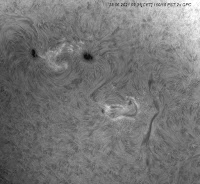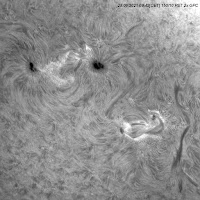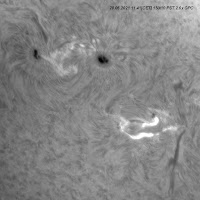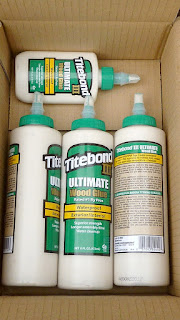*
In
case anyone is interested: My H-a solar telescope is an iStar 150mm
[6"] f/10 H-a, refractor objective in a home made OTA [optical tube assembly] with home
made counter cell, back plate and baffle tree.
H-alpha OTA: Baader
160mm D-ERF full aperture front filter in TE filter housing. Starlight
FTF2535HD Feather Touch focuser. Modified PST etalon for H-a, 50mm
Beloptik.de KG3 & Baader 35nm H-a protection filters on 2" forward
extensions inside the OTA. Lunt B12000S2 straight through, 12mm Blocking
filter, Maier ITF, PST BF. Choice of 1.6x, 2x and 2.6x GPCs on ZWO ASI174MM camera nose.
Massive,
home made, all aluminium, GEM equatorial mounting with 50mm [2"]
stainless steel axes.
Mounted on a 13' high, pyramidal, timber pier in a
home made, 2 storey observatory supporting my home made, 3m [10'] plywood dome.
Goto mounting drives are ASCOM[AWR]Tech[UK.]
Software:Capture: I'm using SharpCap Pro v3.2.6480, Mono 8 AVI, 800x800 10m/s Gain 60. Zoom 125 for capturing 500 frame, AVI videos.
Software stacking: Autostakkert AS!3 3.01.12 [x64] Surface, Improved tracking, Noise Robust2, AP size 16. Zoom 160. 75/500 frame selection.
ImPPG: Lucy-Richardson D Sigma [default 1.3] Iterations 50, Sigma 2.6, Amount 1.35. Saved as 16 bit .TIFF stills to:
Final image polishing: PhotoFiltre7 image handling software. Histogram, Gamma, Contrast and any cropping. Images saved as JPEGs.
My working method is to capture short videos only in moments of good seeing. This is continuously monitored on a large, 27" hi-res monitor using a much enlarged image. I usually get about 100fps with [arbitrary max] 10m/s exposures and 800x800 windows. My laptop now has twin, internal SSDs after some time using external T5 SSDs on USB3. I try to avoid adding Gain if possible.
I then process immediately as I continue to capture more videos. All the processing softwares are kept open during capture for quick turnaround. Which means not having to wait fr them to open and make changes to settings each time.
It would not be an exaggeration to suggest I can quickly publish processed images online. Within 5 minutes of a capture is quite normal. This is quite deliberate on my part. I reasoned that spending lots of time processing to perfection was just not my area of expertise.
Rapid, repeated processing of new material is similar to bulk improvement by constant iteration. The sheer number of captures and their processing means I must have built a successful routine. Provided the seeing is good enough, then no extra processing will improve my close-ups beyond the personally acceptable. The trick is to set my own standards by comparison with other solar imagers.
Concentrating on solar close-ups was another deliberate choice. There are quite a number of solar imagers with expert skills at full disk image processing. They have etalons and filters which allow much more even lighting than my [humble, secondhand] PST etalon.
Investing another £1500 in a Daystar Quark is far too much of a gamble with their present lack of quality control. The astro and solar forums are awash with horror stories about poor quality Quarks. Multiple returns, just to obtain an acceptable product, does Daystar's reputation no good at all. Otherwise all solar imagers would [probably] own at least one Quark. There are several varieties.
Solar Spectrum sell well respected filter products but at multiples of everyday pricing. Well beyond my pocket. They can cost as much as a car. By which I mean a much better car than my 20-year old rust bucket!
A small number of manufacturers offer complete solar telescopes. Again at prices which require a fair income. Or very serious dedication to the pastime. Hence my choice of a modified, secondhand PST. Then building the telescopes and mounting to save tens of thousands on instrumentation.
It could be argued that the results from purchasing a Lunt 152mm H-a scope would be superior. The problem is that it costs in excess of £10k and on upwards. A suitable, commercial mounting, to carry a 6" refractor, would run to another £10k. Add another £10k for a smaller dome than I have already built for myself.
I can claim no great expertise at solar imaging. Fortunately I am now getting results which I find acceptable. It was hard, frustrating work getting this far. I had to learn the techniques of capture and processing from scratch in my mid-70s. My mass production, processing methods and the countless hours practising them, help me to learn from my mistakes. Naturally I study other imagers work, advice and equipment. To add to my rather limited sum of specialist knowledge.
My brain doesn't function well on inscrutable symbols. So several popular softwares remain completely out of reach. Fortunately I have a decade of experience using PhotoFiltre 7. It has just enough tools to finish off my results.
I wish I could claim the later seeing conditions had improved my images but the seeing is absolutely awful now. The wind is also blowing the telescope around. Best to give it all a rest until later. The later session never came around. It became overcast at 18.00.
*

















































